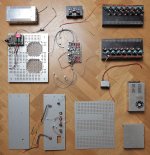Separate speakers are outdated, as are separate amplifiers.
In order to optimize sound quality as well as measured performance, it has become obligatory to regard a loudspeaker driver and its amplification as one single functional unit. In multi-way systems, this implies that an electronic crossover needs to be applied in front of the amplification/driver unit. In the remainder of this thread, I will call this 'direct drive'; the drivers are driven directly by an amplifier, without a crossover network in between.
In professional audio, where neutrality and repeatability are required, this is well accepted. However, the living room has remained resilient. By and large, there are two approaches to direct drive. The first incorporates the crossover network and the amplifiers within the loudspeaker housing. I don't know of any successful domestic loudspeaker which follows this recipe. The second approach consists of separate boxes for the speakers, the electronic crossover, and the different amplifiers. Almost all domestic applications of direct drive follow this latter approach. Most of these systems are an ad hoc assembly of separate components, often re-purposed from their original use. Some manufacturers such as JBL or MBL are on the market with direct drive systems consisting of dedicated components, but still only fill a niche.
The ' Examplifier' I will describe in this thread follows a third approach. Over the coming days, I will zoom into some of the parts of this new piece of kit, but first lets have a view of its innards.

In order to optimize sound quality as well as measured performance, it has become obligatory to regard a loudspeaker driver and its amplification as one single functional unit. In multi-way systems, this implies that an electronic crossover needs to be applied in front of the amplification/driver unit. In the remainder of this thread, I will call this 'direct drive'; the drivers are driven directly by an amplifier, without a crossover network in between.
In professional audio, where neutrality and repeatability are required, this is well accepted. However, the living room has remained resilient. By and large, there are two approaches to direct drive. The first incorporates the crossover network and the amplifiers within the loudspeaker housing. I don't know of any successful domestic loudspeaker which follows this recipe. The second approach consists of separate boxes for the speakers, the electronic crossover, and the different amplifiers. Almost all domestic applications of direct drive follow this latter approach. Most of these systems are an ad hoc assembly of separate components, often re-purposed from their original use. Some manufacturers such as JBL or MBL are on the market with direct drive systems consisting of dedicated components, but still only fill a niche.
The ' Examplifier' I will describe in this thread follows a third approach. Over the coming days, I will zoom into some of the parts of this new piece of kit, but first lets have a view of its innards.

The amplifier will need to be somewhat portable since its prime use will be to travel around and do demonstrations with my new loudspeakers, so I chose for 700 Watts of SMPS, easily saving over 5 kg in weight.
The electronic crossover is shown in the upper middle part. It has relay switched balanced and unbalanced inputs with selectable sensitivity. Power supply is cleaned up by cap multiplier as well as other filtering means.
On the heat sinks, each side has 7 LM3886 amplifier boards mounted; 4 service the bass, 2 the mids, and 1 for the highs.
The PCB on the bottom plate contains the power on/off relays, circuitry for the on/off button and 12v remote switching, as well as circuitry for temperature controlled proportional fans. The latter feature will not be used, since I found no fan to be silent enough.
Another unused bit is on top in the middle. It is a cap multiplier capable of sourcing the power amp, but by doing so, it shaves of quite a couple of volts. Since I had to drop the fans, I had to take this little furnace out. Interestingly enough, this causes a bit more hash on the power rails, but PSRR of the LM3886 is high enough to not see any difference at the output.
The electronic crossover is shown in the upper middle part. It has relay switched balanced and unbalanced inputs with selectable sensitivity. Power supply is cleaned up by cap multiplier as well as other filtering means.
On the heat sinks, each side has 7 LM3886 amplifier boards mounted; 4 service the bass, 2 the mids, and 1 for the highs.
The PCB on the bottom plate contains the power on/off relays, circuitry for the on/off button and 12v remote switching, as well as circuitry for temperature controlled proportional fans. The latter feature will not be used, since I found no fan to be silent enough.
Another unused bit is on top in the middle. It is a cap multiplier capable of sourcing the power amp, but by doing so, it shaves of quite a couple of volts. Since I had to drop the fans, I had to take this little furnace out. Interestingly enough, this causes a bit more hash on the power rails, but PSRR of the LM3886 is high enough to not see any difference at the output.
Last edited:
- Status
- This old topic is closed. If you want to reopen this topic, contact a moderator using the "Report Post" button.